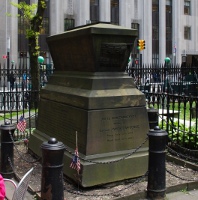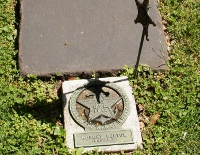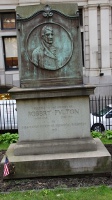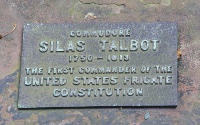Trinity Church at the intersection of Wall Street and Broadway in Lower Manhattan, is one of the oldest congregations in the state. Captain William Kidd was a church elder, in the years before he turned pirate. Captain Kidd donated a block and tackle from his ship to help raise the stones of the first church, when it was built in 1698. The current church is the third built on the spot.
I visited the church and surrounding grave yard yesterday, on a lovely but breezy and cold Friday afternoon, to find the graves of three nautical luminaries – Captain James Lawrence, whose last words, “Don’t Give Up the Ship” have become a popular, if odd, battle cry; Commodre Silas Talbot, best remembered as the second captain of the USS Constitution; and Robert Fulton, the inventor and engineer credited with developing the first commercially successful steamboat.
My task was made easier by the fact that the graveyard now has a wireless internet connection. I pulled up the church website on my laptop and used their animated directory to find the three graves that I sought. The internet connection was invaluable, because while I would have had no trouble finding Lawrence’s crypt, I doubt that that I would have found Fulton’s resting place on my own, even after much searching.
So far, the availability of free wireless access appears to have had no real impact on the churchyard. It is still a sanctuary of trees, grass and tomb stones in the bustling turmoil that is New York City between Wall Street and the World Trade Center. Fortunately, web and email addresses have not suddenly appeared on the tombstones and crypts.

The Crypt of Captain James Lawrence Photo: R. Spiman
Captain James Lawrence – It is hard to miss the crypt of Captain Lawrence. It isn’t in the graveyard itself, but right outside in a courtyard at the southern entrance to the church from Broadway. The crypt is across from the Trinity Root, a post 9/11 sculpture. The courtyard is also where tour groups form up.
Lawrence is famous for dying valiantly in single ship combat between his ship, USS Chesapeake, and the HMS Shannon. His dying words, “Don’t Give Up the Ship” have inspired young naval officers for a century. Nevertheless, his order was ignored by his crew. The battle had been one of the bloodiest in the age of sail, but the British won the fight and Lawrence’s officers had no choice but to surrender. (See our previous post: “Don’t Give Up the Ship” – One of the Odder Naval Battle Cries From a Forgotten War.)
Commodore Silas Talbot January 11, 1751 – June 30, 1813 : Silas Talbot was a soldier, merchant and privateer but spent most of his career in the Continental and then US Navy. He was the second captain of the USS Constitution, now a museum ship in Boston. He was given the rank of commodore for his command of the the Santo Domingo Station in 1799 and 1800.
Commodore Talbot does not have his own tombstone or crypt. He is interred in the family vault of Charles Nicoll. Nicoll left the vault to his nieces, one of whom, Maria DePeyster Bancker, was married to Silas Talbot’s son, George Washington Talbot. George and Maria Talbot would name their first son, Charles Nicoll Talbot. Charles and his younger brother, William Richmond Talbot, were both captured by the British during the War of 1812, but survived to live into their 70s.
 Robert Fulton – Fulton was an American artist, engineer and inventor who designed and built the first working submarine for Napolean, who designed spar mounted torpedoes for the British and developed the first commercially successful steamboat on the Hudson River. His first steam-powered steam vessel, the Clermont, made the 150 mile trip between New York City and Albany in 32 hours. Fulton died at age 50 from pneumonia after attempting to save a friend who had fallen through the ice, while walking with Fulton on the not quite frozen Hudson River,
Robert Fulton – Fulton was an American artist, engineer and inventor who designed and built the first working submarine for Napolean, who designed spar mounted torpedoes for the British and developed the first commercially successful steamboat on the Hudson River. His first steam-powered steam vessel, the Clermont, made the 150 mile trip between New York City and Albany in 32 hours. Fulton died at age 50 from pneumonia after attempting to save a friend who had fallen through the ice, while walking with Fulton on the not quite frozen Hudson River,
His grave is not easy to find. He is buried in his wife, Harriet Livingston’s, family vault. The only indication that Fulton is also buried there is a separate marker which reads, “In Honor of Service in the War of 1812 – Robert Fulton – Engineer.” How did Fulton serve in the War of 1812? In 1814, just before the end of the war, Fulton was commissioned to design a steam powered warship. His floating battery Demologos was delivered after the end of the war and after Fulton’s death. Renamed in Fulton’s honor, the vessel operated for one day before being laid up, seeing no further service.
 While Fulton’s grave is hard to find, he is not forgotten. On the other side of the church yard, immediately next to the crypt of Alexander Hamilton and not far from the vault where Silas Talbot is buried, the American Society of Mechanical Engineers erected an impressive monument to Fulton in 1901.
While Fulton’s grave is hard to find, he is not forgotten. On the other side of the church yard, immediately next to the crypt of Alexander Hamilton and not far from the vault where Silas Talbot is buried, the American Society of Mechanical Engineers erected an impressive monument to Fulton in 1901.
It is fitting, at least, that the memorial to Fulton is close to the grave of Talbot, as the two men knew each other. Talbot, who had invested in real estate and was facing financial pressure resulting from a messy divorce, rented a house to Robert Fulton on 77 Chambers Street for $750 per year. Both men died within two years of each.



Marksmen high up in Shannon’s rigging reckoned “that the hammocks, splinters, and wrecks of all kinds driven across the deck formed a complete cloud.” The two ships became so entangled that Chesapeake could no longer fire at Shannon. Lawrence gave orders to board the British ship, but in vain. He was hit by a musket ball from one of the topmen and carried below. Before he left the deck, his last words were: “Tell the men to fire faster and not give up the ship. Fight her till she sinks!” A modified version of this would serve as a rallying cry for the U.S. Navy: “Don’t give up the ship! http://www.historynet.com/dont-give-up-the-ship.htm
I enjoy traipsing around old cemeteries, and this virtual tour was surprising and informative, Richard. Imagine — a wi-fied cemetery!
Silas Talbot is my 4th great grandfather. Please note that his grave site is incorrectly marked. I worked with Trinity Church to correct their documentation, and have had a new marker prepared. He was, in fact, the second to command the US Frigate Constitution (Old Ironsides), doing so from 1799-1801, succeeding Captain Samuel Nicholson. The marker presently in place, was eroneously prepared and placed by the New York SAR, Empire State Chapter, noting the incorrect information.
Thanks for the clarification. (I fixed the post to reflect it.) I took the grave-marker at face value. I have read Fowler’s biography “Silas Talbot: Captain of Old Ironsides” but it has been some time ago. I should have checked.
Thanks again.